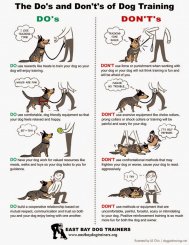Dog training methods

The purpose of this study was to review a series of studies (N = 17) regarding the effects of using various methods when training dogs. The reviewed studies examined the differences between training methods (e.g., methods based on positive reinforcement, positive punishment, escape/avoidance, et cetera) on a dog's physiology, welfare, and behavior toward humans and other dogs. The reviewed studies included surveys, observational studies, and interventions. The results show that using aversive training methods (e.g., positive punishment and negative reinforcement) can jeopardize both the physical and mental health of dogs. In addition, although positive punishment can be effective, there is no evidence that it is more effective than positive reinforcement–based training. In fact, there is some evidence that the opposite is true. A few methodological concerns arose from the reviewed studies. Among them are small sample sizes, missing data on effect size, possible bias when coding behavior in observational studies, and the need to publish case reports of bodily damage caused by aversive training methods. In conclusion, those working with or handling dogs should rely on positive reinforcement methods and avoid using positive punishment and negative reinforcement as much as possible.
play brawl pirates 1win today
Related posts:

 Training your dog to do advanced tricks like finding something or bringing their food bowl can be done with just 10 minutes a day and some clicker training. It’s…
Training your dog to do advanced tricks like finding something or bringing their food bowl can be done with just 10 minutes a day and some clicker training. It’s… 6 Principles of Successful Training 1. Be Consistent: Apply the same rules and the same words all the time. 2. Be Concise: Give your command just once. Repetition…
6 Principles of Successful Training 1. Be Consistent: Apply the same rules and the same words all the time. 2. Be Concise: Give your command just once. Repetition… Cesar Millan Cesar is a best-selling author, public speaker, and internationally acclaimed star of the TV shows “Dog Whisperer with Cesar Millan, ” “Leader of the…
Cesar Millan Cesar is a best-selling author, public speaker, and internationally acclaimed star of the TV shows “Dog Whisperer with Cesar Millan, ” “Leader of the… At Monument Dog Training, we believe that change is always possible . We regularly resolve aggressive behavioral issues, even with dogs who have been written off…
At Monument Dog Training, we believe that change is always possible . We regularly resolve aggressive behavioral issues, even with dogs who have been written off… After years of working with thousands of dogs and their owners, I have seen that the key ingredient people are actually looking for is how to be the Pack Leader…
After years of working with thousands of dogs and their owners, I have seen that the key ingredient people are actually looking for is how to be the Pack Leader…